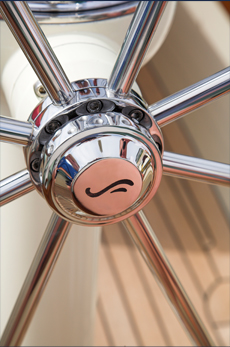About Us

Stability
Over the years, the majority of our designs have incorporated a hull form with relatively heavy displacement, wide beam and a centerboard with shoal draft to provide many advantages for the cruising sailor that we will cover later.
We have further developed two variations on this theme in the form of more performance oriented shoal-draft “delta form” with a deeper, delta-shaped hull and no keel extension, and the Friendship 40’s classic keel/centerboard hull with a centerboard raised into a short keel.
The Friendship 40’s stability and resultant seaworthiness can be divided into three categories;
- The ability to sail at a comfortable angle of heel.
- The ability to resist capsizing in extreme conditions.
- The comfortable motion in waves.
The angle of heel while sailing is primarily based on the initial stability of the boat. Initial stability is considered to be in the range of 0 to 30 degrees. The stability is usually referred to in terms of Righting Moment. Righting Moment is created by the shape of the hull (form stability) and weight distribution (location of the ballast). The more beam a boat has, the more form stability it has. As the Friendship 40 heels, the extra beam on the leeward side provides additional buoyancy which moves the center of buoyancy outboard thus increasing the righting arm. The righting arm multiplied by the displacement creates Righting Moment. The lower the center of gravity is in a boat, the higher the Righting Moment will be. A designer can either lower the ballast (deepen the boat) or increase the ballast (make the boat heavier) to lower the overall center of gravity of the boat. Because of the two components of Righting Moment, it is true that wider boats are more stable than narrower boats and boats with lower centers of gravity are more stable than boats with higher centers of gravity.
A boat’s ability to resist capsizing while in extreme conditions is primarily dependent on the range of positive stability. The range of positive stability is dependent on the relative position of the center of buoyancy and the center of gravity. If the CG is too high, the range of positive stability is smaller. Most large sailing yachts have an adequate range of positive stability. Some smaller sailing yachts that require crew weight on the weather rail to sail at an acceptable angle of heel suffer from inadequate range of positive stability and run the risk of capsizing in extreme conditions (large waves).
A boat is said to have a comfortable motion if the roll (side to side) is not too severe. Roll is measure in amplitude (angle of heel) and period (time from start to finish of a roll). It is undesirable to have an excessive heel angle and it is also undesirable to have a quick, abrupt roll period. The amplitude is a function of the Righting Moment of the boat. More stable boats with higher Righting Moments will heel less than stable boats. The period of roll is a function of the Mass Moment of Inertia (MMI) of the boat. Mass Moment of Inertia of is a measurement of the weight distribution of the boat. Boats with a higher MMI will have longer roll periods. In simplified terms this is because boats with greater mass (heavier) require more heeling force to heel them over. Stated in a different way, for a given wave height, the Friendship 40 will be slower to respond (heel over) than a lighter boat.
In order to demonstrate how the Friendship 40’s design can provide the stability necessary to support a powerful sail plan and remain safe for deep water passages, we have shown the cross-section of the boat as compared to that of a moderate draft keel boat. In comparing these two hull sections you will note that the Friendship 40 has more beam (thus more form stability) than a typical keel boat of the same length. Also note that the center of gravity of the lead ballast is the same or only marginally higher than the deep lead keel because of a much deeper hull profile. Because of the greater hull displacement (or buoyancy), we are able to specify considerably more lead (higher ballast ratio) to compensate for this difference in ballast height. The amount of ballast multiplied by the distance of ballast below the hull's center of buoyancy equals the “ballast moment,” a key component affecting the overall center of gravity which in turn affects the Righting Moment of a boat. A lighter Righting Moment will be a much more tender boat.
